When it comes to residential lighting, LED bulbs outshine CFLs in terms of lifespan and durability. While LED bulbs can last for many years, CFLs tend to have a shorter operational life, making LEDs the more reliable choice for homeowners. Factors such as operating temperature and usage frequency also play a crucial role in determining the longevity of these lighting options.
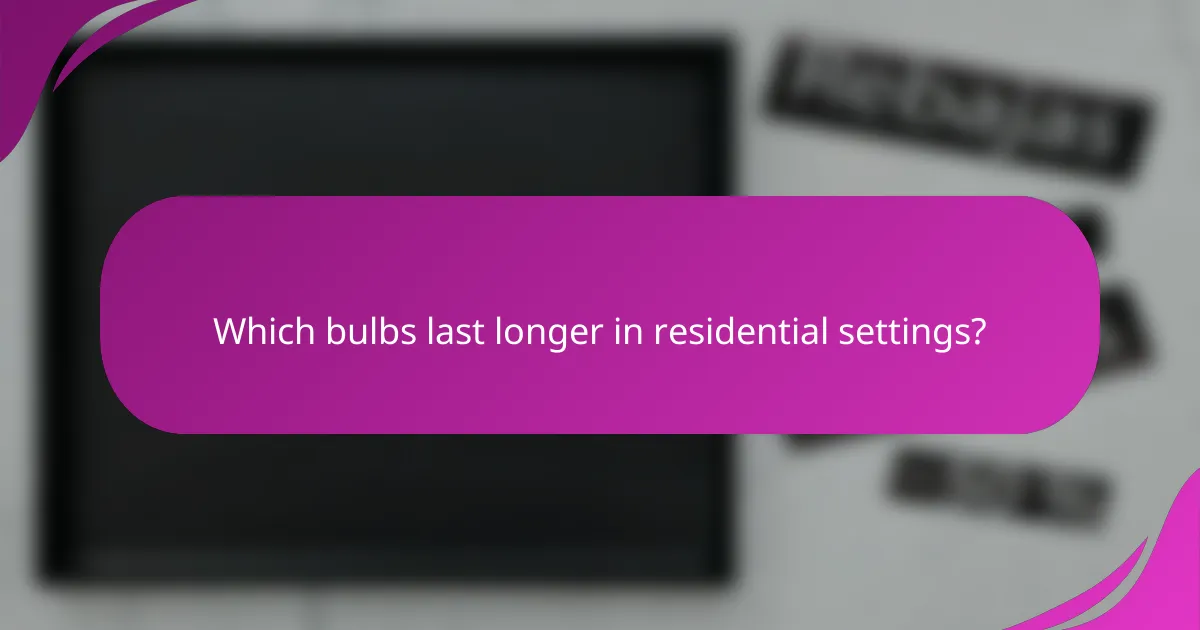
Which bulbs last longer in residential settings?
In residential settings, LED bulbs typically last significantly longer than CFLs. While LED bulbs can function for many years, CFLs have a shorter lifespan, making LEDs a more durable option for home lighting.
LED bulbs lifespan averages 15,000 to 50,000 hours
LED bulbs are known for their impressive longevity, with lifespans ranging from approximately 15,000 to 50,000 hours. This extended duration means that homeowners can enjoy consistent lighting without frequent replacements.
Factors such as usage patterns and quality of the bulb can influence the actual lifespan. For example, using LED bulbs in fixtures that allow for proper heat dissipation can maximize their longevity.
CFLs lifespan averages 7,000 to 15,000 hours
CFLs generally have a shorter lifespan, averaging between 7,000 and 15,000 hours. While they are more energy-efficient than traditional incandescent bulbs, they do not match the durability of LEDs.
Homeowners should consider that frequent on-off cycling can reduce the lifespan of CFLs. Therefore, they are best suited for areas where lights are left on for longer periods rather than frequently switched on and off.
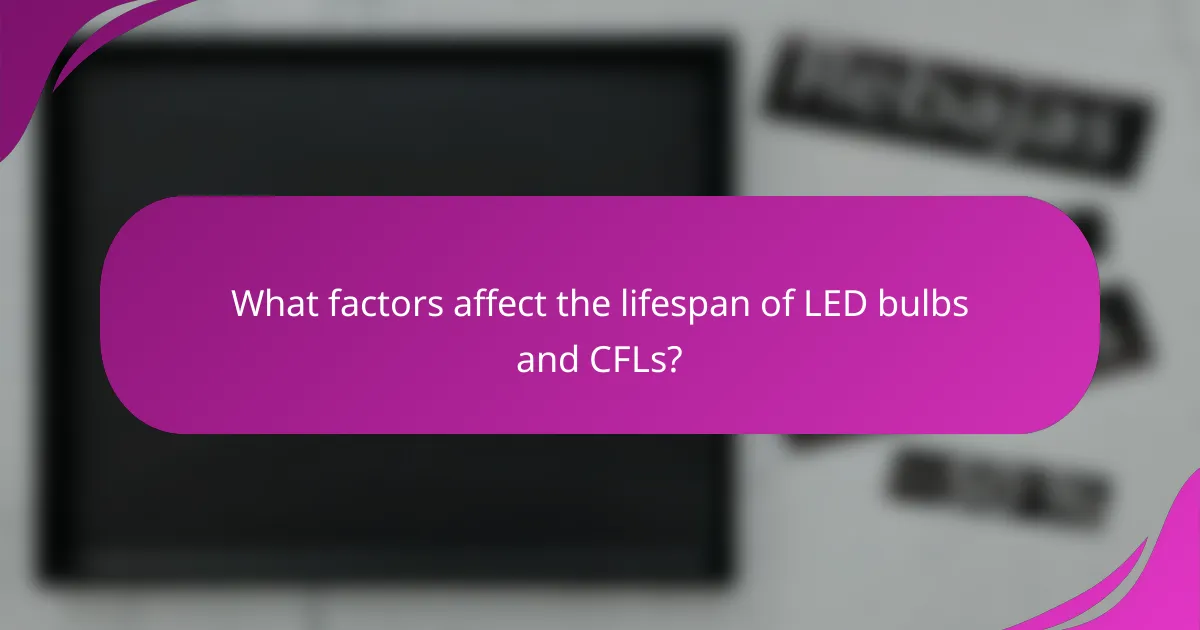
What factors affect the lifespan of LED bulbs and CFLs?
The lifespan of LED bulbs and CFLs is influenced by several key factors, including operating temperature and the frequency of on/off cycles. Understanding these elements can help you choose the right lighting for your home and maximize the longevity of your bulbs.
Operating temperature impacts lifespan
Operating temperature plays a significant role in determining the lifespan of both LED bulbs and CFLs. LEDs generally perform best in cooler environments, while excessive heat can shorten their lifespan considerably. In contrast, CFLs are more sensitive to cold temperatures, which can lead to reduced efficiency and brightness.
For optimal performance, keep LED bulbs in areas where temperatures remain between 0°C and 40°C (32°F to 104°F). CFLs, on the other hand, should ideally be used in spaces that do not drop below 10°C (50°F) to maintain their effectiveness.
Frequency of on/off cycles affects bulb longevity
The frequency with which you turn your bulbs on and off can significantly affect their longevity, particularly for CFLs. Frequent cycling can lead to a reduction in the number of effective hours a CFL can provide, as they are designed for longer, steady use. In contrast, LEDs are more resilient to frequent switching and can handle numerous on/off cycles without a noticeable impact on lifespan.
As a general guideline, if you frequently turn lights on and off, opt for LED bulbs to ensure longer-lasting performance. For areas where lights are left on for extended periods, both LED and CFL options can be suitable, but LEDs will typically offer greater durability and efficiency over time.
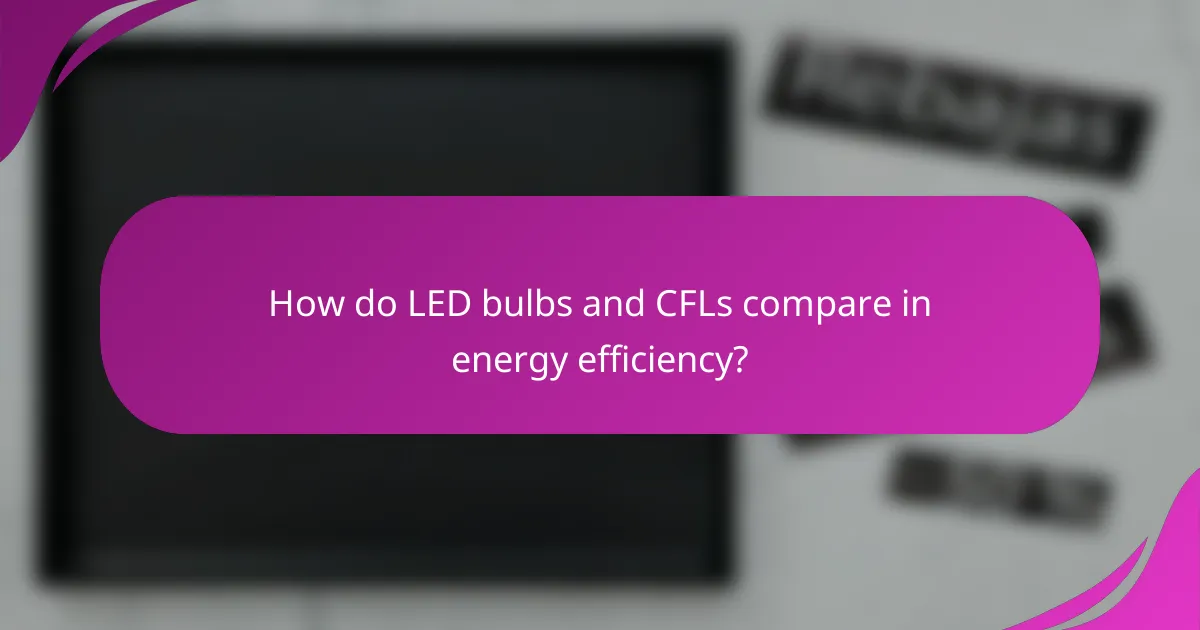
How do LED bulbs and CFLs compare in energy efficiency?
LED bulbs are generally more energy efficient than CFLs, making them a popular choice for residential lighting. Both types of bulbs consume significantly less energy than traditional incandescent bulbs, but LEDs lead in overall efficiency and lifespan.
LEDs use up to 80% less energy than incandescent bulbs
LED bulbs can consume up to 80% less energy compared to incandescent bulbs, which translates to lower electricity bills and reduced environmental impact. For instance, a typical LED bulb may use around 10 watts to produce the same light output as a 60-watt incandescent bulb.
This efficiency means that households can save a substantial amount over the lifespan of the bulb, which can last up to 25,000 hours or more. When selecting LED bulbs, look for the Energy Star label to ensure optimal energy savings.
CFLs use about 75% less energy than incandescent bulbs
CFLs, or compact fluorescent lamps, use approximately 75% less energy than traditional incandescent bulbs. A standard CFL can produce the same light as a 60-watt incandescent while consuming only about 13 to 15 watts.
While CFLs are more efficient than incandescent bulbs, they typically have a shorter lifespan than LEDs, lasting around 7,000 to 15,000 hours. When considering CFLs, be aware that they contain a small amount of mercury, which requires careful disposal to avoid environmental contamination.
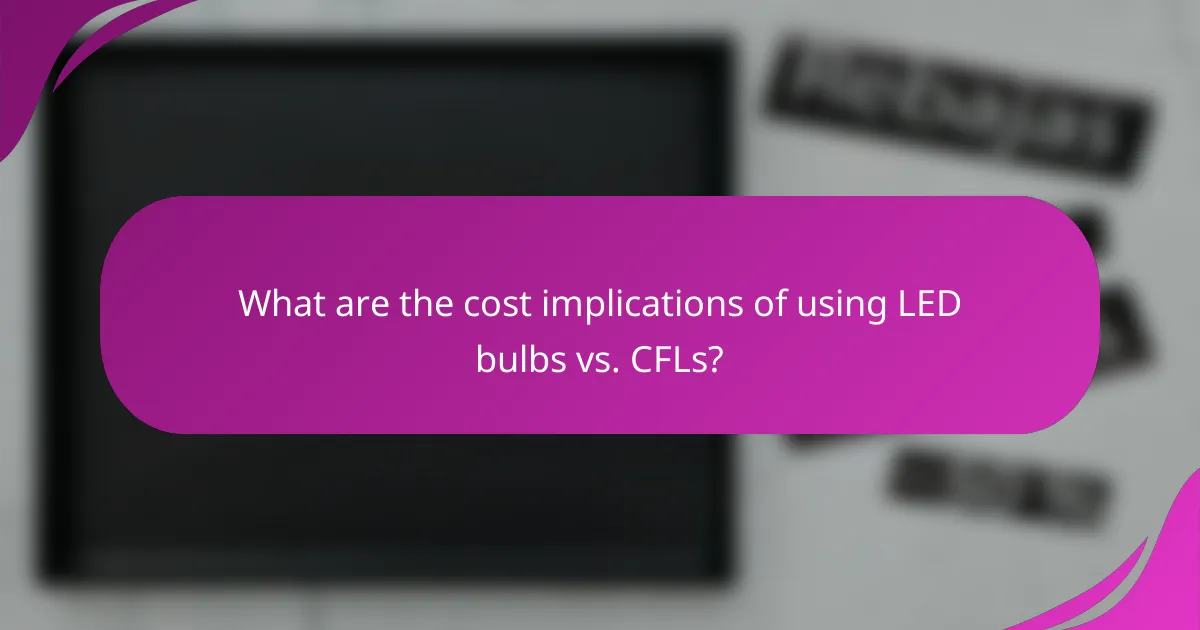
What are the cost implications of using LED bulbs vs. CFLs?
The cost implications of using LED bulbs compared to CFLs involve both initial purchase prices and long-term energy savings. While LED bulbs typically have a higher upfront cost, they offer significant savings on electricity bills over time due to their energy efficiency and longer lifespan.
Initial cost of LED bulbs is higher
LED bulbs generally cost more than CFLs at the point of purchase, often ranging from two to ten times higher. For example, a standard LED bulb may cost around $10 to $15, while a comparable CFL might be priced between $2 to $5. This initial investment can deter some consumers, but it’s essential to consider the overall value.
When budgeting for lighting, factor in the number of bulbs needed and their expected lifespan. Although the upfront cost is greater for LEDs, their longevity can offset the initial expenditure. LEDs can last up to 25,000 hours or more, compared to about 10,000 hours for CFLs, making them a more durable option in the long run.
Long-term savings on energy bills with LED bulbs
LED bulbs provide substantial long-term savings on energy bills due to their lower wattage consumption. An LED bulb typically uses about 8 to 12 watts, while a CFL uses around 13 to 15 watts for similar brightness levels. This difference can lead to savings of up to 80% on energy costs over the bulb’s lifetime.
For instance, if you replace ten 60-watt incandescent bulbs with LEDs, you could save approximately $100 or more annually on electricity, depending on local rates. Additionally, many utility companies offer rebates for switching to energy-efficient lighting, further enhancing the financial benefits of choosing LED bulbs.
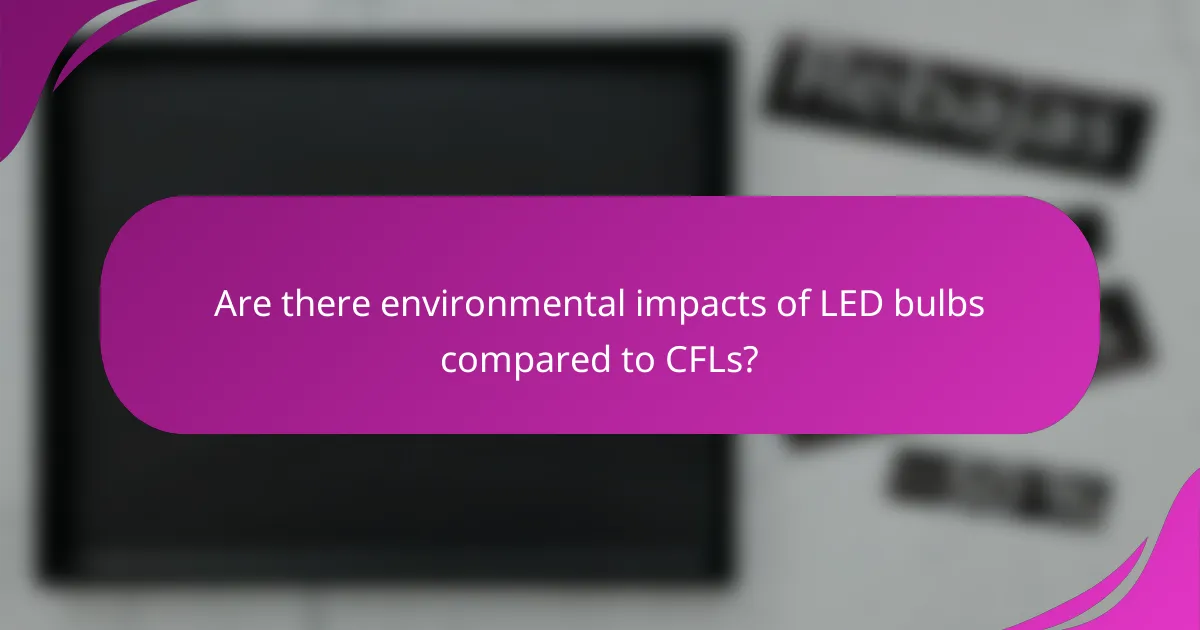
Are there environmental impacts of LED bulbs compared to CFLs?
Yes, LED bulbs generally have a lower environmental impact compared to CFLs. LEDs do not contain hazardous materials, making them safer for disposal and reducing potential environmental harm.
LEDs contain no hazardous materials
LED bulbs are composed of materials that are not harmful to the environment. They primarily use semiconductor materials, which do not release toxic substances when disposed of. This characteristic makes LEDs a more eco-friendly choice for residential lighting.
Moreover, the absence of hazardous materials means that LED bulbs can be disposed of in regular waste without special handling. This simplifies the end-of-life process for consumers and reduces the burden on waste management systems.
CFLs contain small amounts of mercury
Compact fluorescent lamps (CFLs) contain a small amount of mercury, which is a toxic substance. While the mercury content in each bulb is minimal, it poses a risk if the bulbs are broken or improperly disposed of. This necessitates careful handling and specific disposal methods to prevent environmental contamination.
Due to the presence of mercury, CFLs must be recycled at designated facilities rather than thrown away with regular trash. Many localities have regulations regarding the disposal of CFLs, so it’s important for consumers to be aware of their local guidelines to ensure safe disposal.
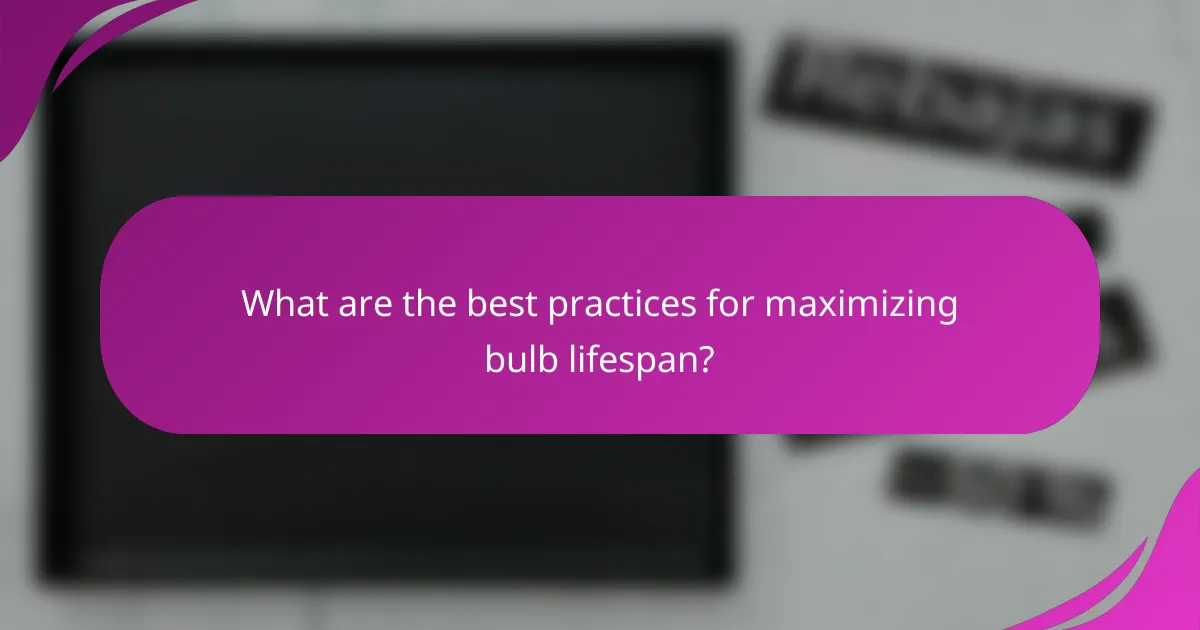
What are the best practices for maximizing bulb lifespan?
To maximize the lifespan of LED bulbs and CFLs, it is essential to use them correctly and in suitable environments. Implementing specific practices can significantly extend their operational life and efficiency.
Use compatible dimmers with LED bulbs
Using compatible dimmers with LED bulbs is crucial for maintaining their lifespan. Not all dimmers work well with LEDs, leading to flickering or reduced performance. Look for dimmers specifically labeled as LED-compatible to ensure optimal functionality.
When selecting a dimmer, consider models that support a wide range of wattages and have good reviews for LED use. This can help prevent issues such as overheating, which can shorten bulb life.
Avoid frequent switching for CFLs
Frequent switching can significantly reduce the lifespan of CFLs. These bulbs are designed to be left on for extended periods; turning them on and off repeatedly can cause wear on the internal components. Ideally, CFLs should be used in fixtures where they will be on for at least 15 minutes at a time.
For areas where lights are frequently turned on and off, consider using LED bulbs instead, as they are less affected by this behavior and can handle frequent cycling without a significant impact on their lifespan.
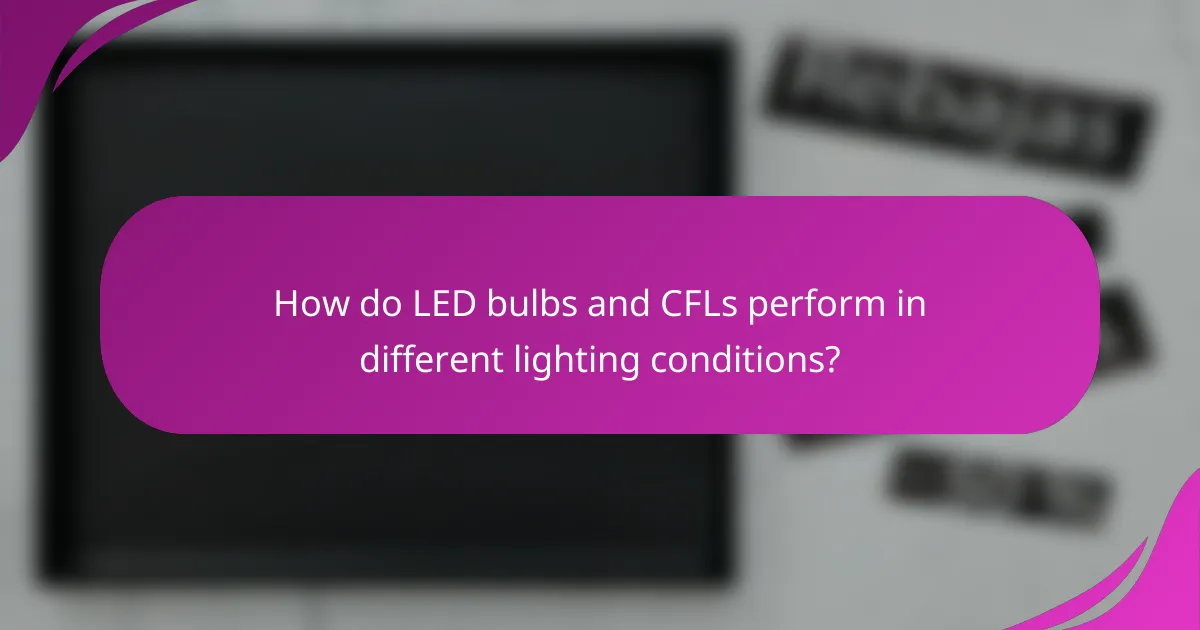
How do LED bulbs and CFLs perform in different lighting conditions?
LED bulbs generally outperform CFLs in various lighting conditions, particularly in colder environments. Their ability to maintain brightness and efficiency in low temperatures makes them a more reliable choice for diverse residential settings.
LEDs perform well in cold environments
LED bulbs are designed to function efficiently even in cold temperatures, making them ideal for outdoor lighting or unheated spaces. They can operate effectively in temperatures as low as -20°C to -30°C, maintaining their brightness and energy efficiency.
This resilience in cold conditions means that homeowners can rely on LEDs for consistent performance during winter months, reducing the need for frequent replacements or maintenance.
CFLs may struggle in extreme cold
CFLs, on the other hand, often experience reduced performance in cold environments. When temperatures drop below 0°C, these bulbs can take longer to warm up and may emit less light than expected.
This limitation can lead to frustration for homeowners who rely on CFLs for outdoor or unheated areas, as they may not provide adequate illumination when needed most. In such cases, switching to LED bulbs can be a more effective solution.


